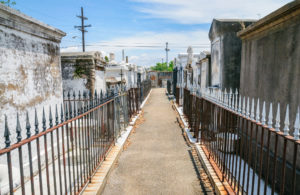
New Orleans is not only a living intersection of cultures, but it’s also a city with a multifaceted, unique and troubled past. Founded nearly three centuries ago as a French colony, it was influenced by the Indigenous Americans originally living on its land, later European immigration and influxes of African slaves brought to the area. This distinctive amalgamation has given rise to fascinating folklore, history and people. One local legend, the famous Marie Laveau, still leaves her mark on religion and popular culture today.
Fictional Depictions of Marie Laveau
Direct depictions and inspired echoes of this real-life Crescent City figure can be found in movies, television, novels and comic books. She appears in “American Horror Story: Coven” as an immortal witch with elegant sartorial sensibilities and a vengeful personality. The film “Blues Brothers 2000” includes a character named Queen Mousette, a 130-year-old sorceress roughly based on Laveau. In her 1995 book “Voodoo Dreams: A Novel of Marie Laveau,” novelist Jewell Parker Rhodes shows her escaping an abusive relationship with John, a controlling lover who used her powers for his own gain. In the early 1970s, Laveau was reimaged by Marvel Comics as a powerful sorceress who remained eternally young and beautiful by imbibing a potion made from vampire’s blood.
Who Was the Real “Voodoo Queen”?
Those riveted by legends of Laveau may find that truth differs greatly from fiction. It’s further complicated by the fact that she had an eponymous daughter, Marie Laveau II, who followed in her footsteps. However, various accounts and confirmable facts suggest that she was a powerful, respected religious and community leader.
Most sources agree that the elder Laveau was born in 1801 in New Orleans’ French Quarter. Yet even her parentage is disputed, with some insisting her father was a white plantation owner while others stating he was a “free man of color” with mixed African and French heritage. Throughout her lifetime, she was said to be a liquor importer, matchmaker and hairdresser, offering her services as the latter to the city’s wealthy elite. The Atlas Obscura reveals that she also told fortunes, imparted advice and created “gris gris,” charms believed to protect the wearer from evil spirits or bring good luck. As a priestess, she performed private rituals and exorcisms, provided medical care to victims of yellow fever and ministered to criminals scheduled for execution by sitting with them and preparing their last meals.
No account about Marie Laveau would be complete without the mention of her public St. John’s Eve rites. As Smithsonian Magazine disclosed in a June 2017 article, she hosted these gatherings every June 23 on the banks of Lake Pontchartrain. A major holiday in both Louisiana Voodoo and Haitian Vodou traditions, St. John’s Eve celebrations include both feasting and head-washing rituals to commemorate St. John the Baptist, herald the summer solstice and serve as symbols of renewal and rebirth. Despite city council laws that prohibited black people from holding large public gatherings, Laveau’s annual festivities continued for decades, drawing thousands of worshipping attendees and white spectators. Moreover, she is frequently credited with exposing Voodoo rituals to the public eye through these events.
Revered After All These Years
Although Laveau passed away in 1881, she is still a loved and revered figure. Her tomb, located inside St. Louis Cemetery Number 1, was a popular destination of devotees hoping to have her grant their wishes. Due to numerous instances of vandalism, public access to the site is now only available with an accompanying tour guide. Nevertheless, enthusiastic pilgrims, interested occultists and curious tourists continue to visit her final resting place. Meanwhile, stories are still told about New Orleans’ most famous Voodoo queen, earning her a place in history, local legends and popular culture.

